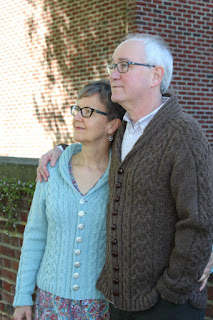Knitting the Top-Down Raglan Cardigan, Part Four
We've finally arrived at the button and buttonhole bands of the cardigan. If you've been knitting your own cardigan along with reading these posts, I know you're pretty glad to have an entire sweater sitting before you--with no seams!
And that's one reason I chose the picked-up button bands for this sweater. There are other ways to construct a button band, one of which is to knit the band separately and seam it to the front openings. To keep this cardigan seamless, let's work it with picked-up stitches.
The pickup ratio for any part of any sweater (when adding an edge to the side of the fabric) usually goes like this--for lightweight yarns, a pickup ratio of three stitches for every four rows, and for heavier weights, a ratio of two stitches for every three rows. That's for knitting Stockinette Stitch perpendicularly onto the same stitch pattern. But we are working with two different stitch patterns and those two have different gauges. It gets even more complicated than that.
Stay with me.
The body of the cardigan is worked in Stockinette stitch, but the button bands are worked in 1/1 rib. Of course those two have different stitch gauges!
My cardigan knit with Schaefer Nichole on size 4 needles has a stitch gauge of 6 spi (stitches per inch), but 1/1 rib with these materials has a gauge of 5.75 spi on the button bands and 7 spi on the body edge and cuff. Why the difference?
You can see in the above picture that the ribbing on the cuff is more contracted than that on the buttonhole band, even though they are the same type of stitch. One reason is that the rib on the cuff is worked directly onto the sleeve at the end of the Stockinette stitch sleeve--it is knit in the same direction. The rib on the buttonhole band is knit along the edge, or perpendicular to the Stockinette stitch. They each serve a different function and behave differently according to that function. The rib on the body edge and the cuff (especially the cuff) need to hug that area of the body. The rib on the buttonhole band needs to lie smoothly along the front edges and hold the holes for fastening the buttons. The opposite button band needs to lie smoothly along the other front edge and hold the buttons themselves.
Okay, back to picking up stitches.
Before I started, I placed a marker two rows below my last neck edge increase so that would know where to stop picking up stitches. I did pick up three stitches for every four rows because it felt like it was behaving well that way. You will need to do what feels best for you.
In the picture above, you can see that for every three stitches there is a slight gap where I skipped a row.
Truly, the only way to know is to just pick up stitches, knit the band, bind off all the stitches, and lay it flat to see that it doesn't pull in too tightly or get all wavy because it's too loose. If you don't like it, rip it and adjust. If its too tight, pick up more stitches, and if it's too loose, pick up fewer stitches.
When working the button bands on my 3-spi version of the cardigan, I started by picking up two stitches for every three rows (as shown above) and soon determined that it was going to be too tight. I switched to three stitches for every four rows and it came out fine.
Once the button band was complete, I used markers to decide where to place my buttons. Then I replaced each marker with a button sewn on. This is all made easier with the use of ribbing to help you read the stitches. In this case, I was able to make the placement fall so that there were six knit stitches between each button (in other words, 13 stitches between each) and I attached the button to the next knit stitch. The lower button was placed six stitches above the lower edge, because I like for that lowermost button to fall in the middle of the body rib height. The topmost button was placed 14 stitches below the top edge because the very last stitch column is where I will pick up for the collar, making it disappear.
To knit the collar, pick up stitches at the top of the button band (one for each row of the band), more stitches along the right neck edge at the same rate as the band, all the stitches at the top of the right sleeve, all the stitches along the back neck, all the stitches at the top of the left sleeve, the same number along the left neck edge as the right neck edge, and then one stitch for each row of the buttonhole band.
Yes, you may have noticed that I made the buttonhole and button band "backward." I say, out with that silly antiquated notion! Put the buttons on either side as to preference (or because you weren't paying attention). Will the planet stop spinning? I can attest that it will not.
Bravo to you if you have knit your cardigan. Bravo to you if you are thinking about knitting a cardigan. Any of the Figheadh Fundamental Top-Down Cardigans is a good place to start, as are any of the Figheadh Fundamentals. Each pattern has multiple sizes and instructions for knitting all those sizes in any of four yarn weights, which means you could use them for any yarn in your stash!
Thank you for following along on the top-down cardigan party. I could honestly just knit from this pattern forever, but I guess I'd better get back to some scrappy socks! I'll show you that next time.
Happy Knitting!







Comments